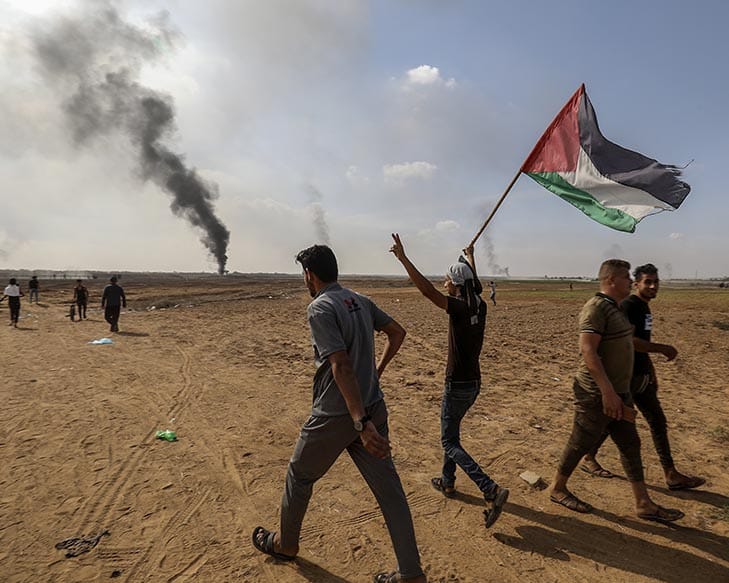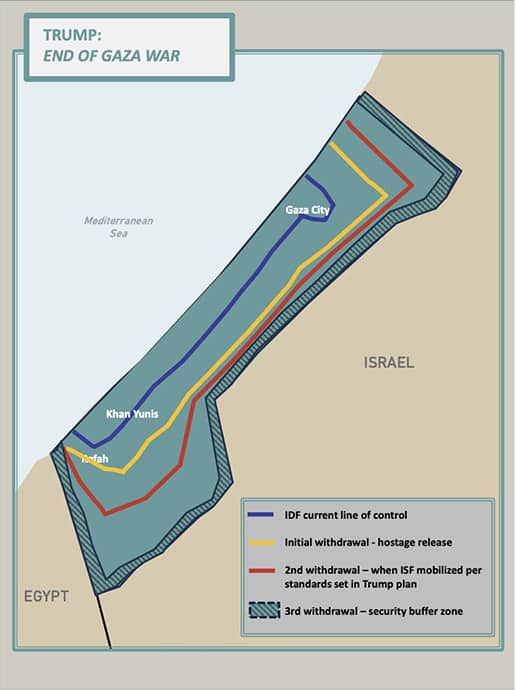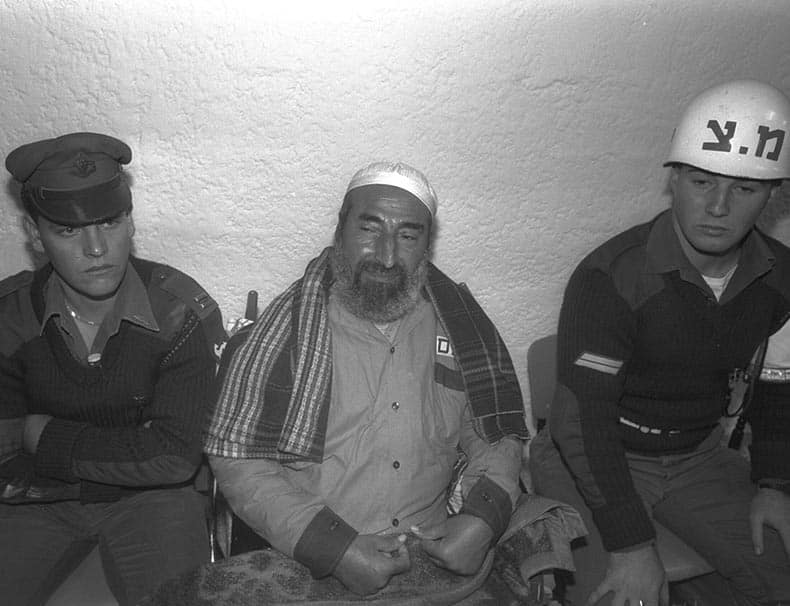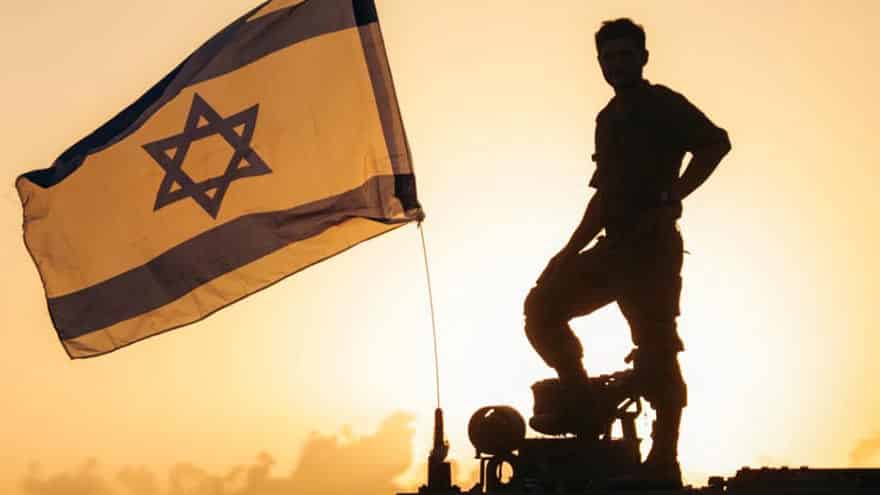U.S. President Donald Trump’s 21-point plan was launched on the eve of Simchat Torah, coinciding with the entry into force of the ceasefire, the release of all living hostages, and some of the deceased ones. Yet almost immediately, difficulties emerged in the path toward further implementation, and unsurprisingly, questions are multiplying about the chances of turning this ambitious plan from theory into reality.
The American plan, formulated together with various mediators, was announced on September 29 at a joint press conference held by President Trump and Israeli Prime Minister Benjamin Netanyahu at the White House. The first stage, as mentioned, was the release of the Israelis kidnapped in Hamas’s terrorist attack of October 7, 2023, in exchange for the release of Palestinian security prisoners.
Beyond that, it includes the disarmament of Hamas; the demilitarization of the Gaza Strip under international supervision; and the transfer of governance in the area to a technocratic, apolitical Palestinian committee that will provide services and operate under the oversight of a new international transitional body—the “Palestinian Peace Council”—to be headed by the President of the United States, with the participation of other leaders including former British Prime Minister Tony Blair.
The plan also calls for the establishment of a temporary International Stabilization Force (ISF), which will train Palestinian police units, coordinate with Egypt and Jordan, and work jointly with Israel and Egypt to ensure border stability and prevent arms smuggling; a gradual Israeli withdrawal from the Strip in accordance with the progress of demilitarization, excluding the security perimeter area; the reconstruction of Gaza with a commitment that Israel will not annex it; the option for residents to leave and return at will; and a declaration of the potential establishment of a future Palestinian state, subject to reforms within the Palestinian Authority.
From the original 21-point plan, one clause was removed after being implemented earlier during the meeting between President Trump and Prime Minister Netanyahu. This clause referred to Netanyahu’s apology to Qatari Prime Minister Mohammed bin Hamad Al Thani for the Israeli strike against Hamas’s external leadership in Doha (on October 9), along with a promise that Israel would never again carry out attacks on Qatari soil.
They Don’t Try to Hide It: Aspiring to Another October 7
President Trump’s framework for ending the war is the product of three main factors whose convergence created a powerful and decisive effect on its implementation. The first was the increasing military pressure exerted by IDF forces on Hamas’s central military and governmental stronghold in Gaza City. The second was Operation Summit of Fire—the failed attempt at a targeted strike in Doha—which, despite its failure, sent an unequivocal message from Israel that the Hamas leadership remains a legitimate target wherever it seeks refuge. The third, and perhaps decisive, factor was President Trump’s determination to advance the first stage of his plan within a short and defined time frame.
In the outline he sought to advance for Gaza, the American president skillfully presented the Israeli government with a deal that included its core demands—the release of all hostages, along with Israel’s consent to only a partial withdrawal from the Strip.
Hamas’s agreement to President Trump’s plan reflects the organization’s waiver of its long-standing demand, declared since the start of the war, that Israel withdraw entirely from the Strip as a precondition for the release of the hostages it held. The first stage of the framework was carried out in practice through the return of all living hostages (as of this writing, Hamas has not fulfilled its commitment to return all the bodies of the deceased). The next stage, as noted, pertains, among other things, to the disarmament of Hamas and the replacement of its rule in Gaza. This stage will involve Arab and other states, Tony Blair, UN representatives, and the United States.
If, in the end, the clause concerning Hamas’s disarmament is not implemented, the organization could, over time, reassert its strength under the protection of a temporary administration in the Strip. Such a situation would allow Hamas to run Gaza’s affairs from behind the scenes, following a model similar to that of Hezbollah’s operation in Lebanon until recently. The third stage deals with laying the groundwork for the future establishment of a Palestinian state, conditional on the successful implementation of the second stage—particularly the disarmament of Hamas and the required reforms within the Palestinian Authority.
Hamas’s resistance to the demand that it disarm has been reflected in recent statements by senior officials of the organization. One particularly notable figure in this regard is Osama Hamdan, who served as Hamas’s representative in Iran during the 1990s and later, until 2024, as its representative in Lebanon. During the Swords of Iron war, Hamdan served as Hamas’s spokesperson to the media, appearing from Lebanon in interviews with Arab and international outlets. In his remarks, he predicted that “within ten years, Israel will cease to exist and will no longer appear on the region’s map.” He described the stages in the struggle against Israel—from “stones and knives” to rocket fire—and declared that Hamas’s October 7 attack was “the battle that advances the Palestinian war of liberation and the end of Israel.”
In another interview with Al Jazeera, Hamdan noted that before the October 7 attack, the Palestinian issue “had fallen into oblivion,” while afterward, more than 150 countries recognized a Palestinian state: “Although the Palestinian people have not yet achieved a decisive victory that would end the occupation, they have come closer to it than ever before… Our people will achieve victory in a future round against the occupation.” Ghazi Hamad, a senior Hamas operative from the Gaza Strip who has been residing in Qatar for the past two years, also emphasized in a media interview that Hamas intends to repeat an attack similar to that of October 7 in the future.

Destruction and Hatred at the Heart of the Ideology
These positions of Hamas leaders regarding the continued struggle against Israel take me back more than thirty years, to the period when Hamas was founded in the Gaza Strip, just days after the outbreak of the First Intifada on December 9, 1987. During my military service at the time, I served as head of the Arab Affairs Department in the Civil Administration, which functioned as the intelligence unit of the governing apparatus in the field. Beyond its primary mission of collection, research, assessment, and formulating policy recommendations, the department also operated as an executive arm for advancing concrete administrative and political initiatives on the ground.
As part of my duties, I frequently met with the top leadership of Hamas in Gaza, who, before the outbreak of the Intifada, had operated through a religious-Islamic association called Al-Mujamma al-Islami. The head of this association was Sheikh Ahmed Yassin, the driving force behind Hamas’s creation. It is no coincidence that the date on which the organization’s first leaflet, signed by Sheikh Yassin, was distributed—December 14, 1987—was designated as Hamas’s official founding day.
In all my meetings with senior Hamas officials, one dominant characteristic stood out clearly: a demonstrative expression of hostility directed toward me personally—as an IDF officer, as a Jew, and as an Israeli. In every meeting, without exception, none of the senior members of the organization bothered to conceal their intense hatred toward me, to the point where I felt as if my very flesh was burning under the scorching gaze of their hatred. This hostility was evident not only in the tense atmosphere of our meetings but also in their unwillingness to cooperate during conversations. It was clear that in every such encounter, they deliberately chose their words sparingly, limiting themselves to short, terse replies—as if maintaining a vow of silence.
The call for the destruction of Israel—a central tenet of Hamas’s ideology—was well known even before the organization’s establishment at the start of the First Intifada. I vividly recall a search operation we conducted several weeks before the uprising at the Islamic University, one of the strongholds of the radical Islamist movement in Gaza. During that late-night search, we found inciting materials against Israel, including the antisemitic forgery from Tsarist Russia known as The Protocols of the Elders of Zion, as well as caches of cold weapons. In the rector’s office, I saw an Israeli flag hanging on the wall, with a dagger driven through the center of the Star of David, drops of blood dripping from it, and beneath the flag the slogan: “The destruction of Israel – a command from the Quran.”

Until the Last Jew on Earth
As mentioned, Sheikh Yassin played a central role in shaping Hamas’s ideological principles and positions, which were formulated in absolute and unequivocal terms, leaving no room for interpretive nuance. In this context, I will never forget a meeting that poet Haim Gouri held in my office in the Israeli Civil Administration in Gaza, a few months after the outbreak of the First Intifada. Gouri approached me in his capacity as a journalist, seeking to meet in Gaza to gain a firsthand impression of the situation in the Strip. My attempts to dissuade him from carrying out his journalistic mission in the midst of a violent uprising were unsuccessful, and in the end, we met in my office in the heart of Gaza City.
To provide him with a broad perspective of the prevailing attitudes and opinions among the local population, I invited four senior Palestinian figures to join the meeting, hoping they would represent the spectrum of political and religious views on the ground—from the radical left to fundamentalist Islam. Among the four, Sheikh Yassin stood out in particular, and my encounter with him felt almost surreal. At the long table in my office sat Gouri, a quintessential Israeli poet, a Palmach fighter and commander, a member of the founding generation of the state—and to my left, confined to his wheelchair, sat the man who was the driving force behind the establishment of Hamas and its leader.
“How do you view the existence of Israel as a Jewish state?” asked Gouri.
“Look,” replied Sheikh Yassin, “throughout history, there have been kingdoms and empires—where are they today? There was the Roman Empire—where is it now? The Ottoman Empire, the Third Reich, the British Empire—where are they today?” After listing the vanished empires, he concluded with the words ‘hakadha Israel’—“so it shall be with Israel.” Seeing the shock spread across Gouri’s face, Yassin hurried to appease him and added, “But we Muslims will be ready to recognize you Jews as Ahl al-Dhimma—‘protected people’—under the wings of Islamic rule.” When the meeting ended, I told Gouri that in those few sentences, he had just heard the complete Islamic doctrine on Israel, straight from the ideological school of the Muslim Brotherhood.
It is important to note that Hamas’s stance toward Israel is clearly reflected in the organization’s main ideological document—the Hamas Charter (Mithaq Hamas), published in Gaza about six months after the outbreak of the Intifada, in May 1988. The charter includes a hadith (a collection of sayings and stories about the Prophet Muhammad and his life, forming the second most important source of Islamic law after the Quran), which refers to the “end of days,” when, according to Islamic belief, Muslims will fight the Jews until only one Jew remains on earth, hunted by a pursuing Muslim. In this apocalyptic vision, divine intervention occurs: the tree or stone will speak and reveal to the Muslim that a Jew is hiding behind it, calling him to come and kill him.

The Terrorists of the Future Cycle of Attacks
Returning to the present: as the first stage of President Trump’s plan nears completion, Hamas is exploiting the allotted time to reestablish its standing on the ground as the dominant military and governing power in the Strip—despite the heavy blow dealt to it by the IDF during the war. It is expected to continue doing so until the next stage of Trump’s plan is implemented, improving its military and operational capabilities by recruiting new young fighters into its ranks, reorganizing, and replenishing its stockpiles of weapons and ammunition.
The release of thousands of terrorists during the first stage of the plan’s implementation is expected to give fresh momentum to future terrorist activity against Israel. In this context, the IDF and Israeli security forces must prepare to confront attempts to carry out attacks not only from Gaza but also from the West Bank, where some of the released prisoners have already returned as part of the deal.
The large-scale release of Palestinian prisoners constitutes a significant achievement for the Palestinians within the broader conflict that began on October 7. About 250 of those released are prisoners “with blood on their hands,” serving life sentences for terrorist attacks that killed Israeli civilians before the war, and another 1,700 were detained after October 7, 2023. Such a massive release, based on experience, will almost certainly strengthen public support for Hamas and lead some of those released to rejoin the cycle of terror against Israeli targets in the future.
At the same time, Hamas can claim another achievement: Israel’s agreement to reopen the Rafah crossing for Palestinian movement and for the entry of humanitarian aid into Gaza (as of this writing, the crossing has not yet reopened, serving as leverage on Hamas to fulfill its commitment to return the remaining bodies of the deceased). In addition, Hamas has received assurances from elements of the international community, led by President Trump, guaranteeing a halt to the war. The postponement of the disarmament clause and the demilitarization of the Strip to a later stage in Trump’s 21-point plan will allow Hamas to preserve its military capabilities for an extended period.
As the first stage of the agreement’s implementation draws to a close, Israel can claim a notable achievement in its military and security control over more than half of the Strip’s territory. Another significant success is Israel’s refusal to release “heavy” Palestinian prisoners such as Marwan Barghouti, Ahmad Sa’adat, Hassan Salameh, and Abbas al-Sayyid, despite intense pressure. The Nukhba terrorists who participated in the October 7 attack were also not included in the release, despite Hamas’s demand for their inclusion in the indirect negotiations with Israel.
On the diplomatic front, the end of the war presents Israel with a strategic opportunity to restore its relations with Western European countries after the deterioration caused by widespread public protests and pro-Palestinian sentiment. At the same time, Israel must invest significant effort in expanding the Abraham Accords and advancing normalization with additional Arab states, as well as Islamic countries, with a particular emphasis on Indonesia.








